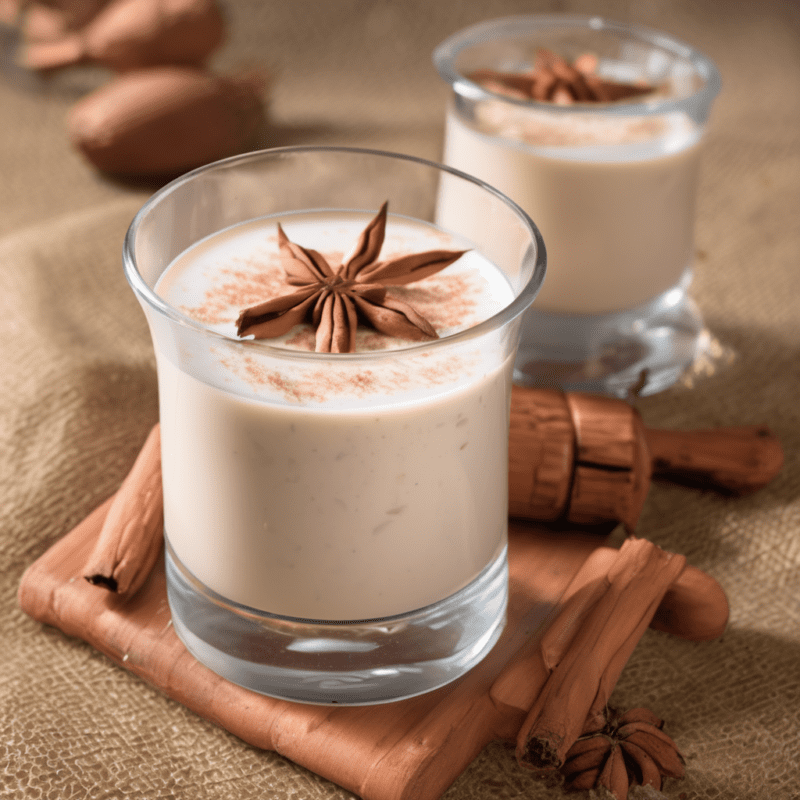Uncovering the Delight of Puerto Rican Eggnog
Delving into the world of classic holiday beverages, we find Puerto Rican eggnog, a delightful concoction known for its rich, creamy goodness. This traditional drink, locally known as Coquito, is a holiday staple with a fascinating history and an even more delicious taste.
The Roots: History and Tradition
Puerto Rican eggnog, or Coquito, is deeply rooted in Puerto Rican culture and tradition. This rich, creamy drink is a must-have during holiday celebrations, with its unique blend of ingredients that bring joy to the festive season. Its origins trace back as an evolution of the Spanish ‘ponche’, a milk-based spiced rum. The drink evolved over time with each generation adding their unique touches, resulting in the Coquito we know today.
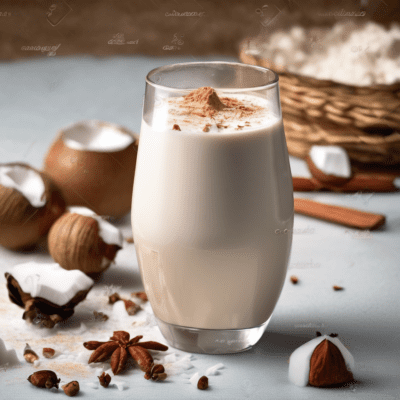


Key Elements: Unveiling the Ingredients
Unveiling the ingredients of Puerto Rican Eggnog, known as Coquito, reveals a harmonious blend of flavors that evoke the warmth and vibrancy of the Caribbean. At the heart of this delectable beverage lies a carefully curated selection of ingredients, each contributing to its distinctive taste and creamy texture.
- Coconut Milk: The star ingredient of Coquito, coconut milk lends a luscious creaminess and a subtle tropical sweetness to the drink. It forms the foundation upon which the other flavors are layered, infusing the beverage with a hint of exotic flair.
- Sweetened Condensed Milk: Adding richness and sweetness, sweetened condensed milk is a crucial component of Coquito. Its thick consistency helps to create a velvety texture while enhancing the overall sweetness of the drink.
- Evaporated Milk: Another dairy element, evaporated milk, contributes to the creaminess of Coquito while providing a slightly caramelized flavor note. It adds depth to the beverage and helps to balance out the sweetness of the other ingredients.
- Rum: A staple in Caribbean cuisine, rum infuses Coquito with a distinct warmth and complexity. Whether using white rum for a lighter touch or opting for spiced rum for a more intense flavor profile, the addition of rum is essential for authenticity and depth of flavor.
- Cinnamon: Aromatic and warming, cinnamon adds a spicy-sweet element to Coquito that complements the creamy base. Its presence lends depth and complexity to the drink while imparting a familiar holiday aroma.
- Nutmeg: Providing a subtle earthiness and a hint of nutty sweetness, nutmeg is a classic spice in Coquito that enhances its overall flavor profile. When freshly grated, nutmeg adds a delicate fragrance and a nuanced taste that elevates the drink to new heights.
- Vanilla: Often used to round out the flavors and add a touch of sweetness, vanilla extract enhances the overall aroma and richness of Coquito. Its warm, floral notes mingle with the other ingredients, creating a harmonious symphony of flavors.
- Optional Ingredients: While the above ingredients form the foundation of traditional Coquito, there’s room for experimentation and personalization. Some variations may include additional ingredients such as cloves, almond extract, coconut cream, or even chocolate, allowing for endless creativity and customization.
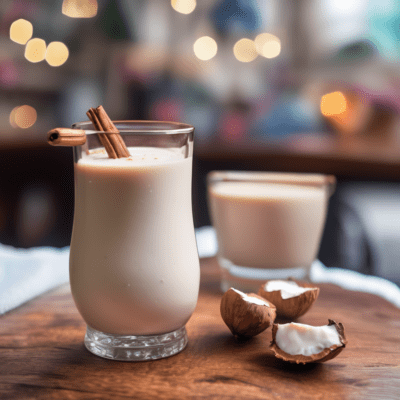


Highlighting the Cream
Highlighting the creaminess of Puerto Rican Eggnog, also known as Coquito, unveils one of its most irresistible qualities that sets it apart from traditional eggnog. This coquito recipe’s creamy texture is not just a result of one ingredient but a combination of carefully selected components that work together to create a velvety-smooth indulgence.
- Coconut Milk: The primary contributor to Coquito’s creaminess is coconut milk. Unlike traditional eggnog, which relies on dairy milk, fresh coconut milk brings a rich and luxurious texture to the drink. It’s thicker and silkier, coating the palate with a decadent mouthfeel that’s reminiscent of the tropics.
- Sweetened Condensed Milk: Adding to the creaminess is sweetened condensed milk. This thick and sweet dairy product not only enhances the overall richness of Coquito but also contributes to its smooth consistency. It melds seamlessly with the coconut milk, creating a velvety base that’s both comforting and indulgent.
- Evaporated Milk: Another dairy element that boosts the creaminess of Coquito is evaporated milk. With its concentrated flavor and creamy texture, evaporated milk adds depth to the drink while further enhancing its silky mouthfeel. It rounds out the flavor profile, giving Coquito a satisfyingly smooth finish.
- Coconut Cream (Optional): For those looking to amplify the creaminess even further, coconut cream can be added to the recipe. This ultra-rich and thick coconut-derived product intensifies the coconut flavor while imparting a luxurious creaminess that’s hard to resist. It elevates Coquito to new heights of decadence and indulgence.
- Blending Technique: Beyond the ingredients themselves, the method of preparation plays a crucial role in achieving the desired creaminess. Proper blending is essential to ensure that all the ingredients are thoroughly combined and emulsified, resulting in a consistently smooth texture. Whether using a blender or a hand mixer, the goal is to create a creamy and cohesive mixture that’s irresistibly velvety.
By highlighting the creaminess of Puerto Rican Eggnog, enthusiasts can appreciate the luxurious texture that sets this Coquito recipe apart from its counterparts. With its silky smoothness and indulgent mouthfeel, Coquito delights the senses and provides a truly decadent drinking experience that’s perfect for any occasion.



Recipe: Crafting Your Perfect Eggnog
Making your Puerto Rican eggnog is a simple, straightforward process that doesn’t require any fancy bartending skills. Moreover, you can adjust the recipe to suit your taste, adding more or less rum, sugar, or spices as you prefer. Remember, the key to a great Coquito recipe is quality ingredients and the right balance of flavours.
Ingredients:
- 4 large eggs, separated
- 1/2 cup granulated sugar
- 2 cups whole milk
- 1 cup heavy cream
- 1/2 teaspoon ground cinnamon
- 1/4 teaspoon ground nutmeg
- 1 teaspoon vanilla extract
- Optional: Rum, brandy, or bourbon to taste
- Optional: Whipped cream, ground cinnamon, or nutmeg for garnish
Instructions:
- Separate the egg yolks from the whites into two different bowls. Set aside the egg whites for later use.
- In a mixing bowl, beat the egg yolks with the granulated sugar until pale and creamy.
- In a saucepan, combine the whole milk and heavy cream. Heat the mixture over medium-low heat until it’s warm but not boiling, stirring occasionally.
- Slowly pour the warm milk and cream mixture into the bowl with the beaten egg yolks and sugar, whisking continuously to prevent the eggs from curdling.
- Return the mixture to the saucepan and cook over low heat, stirring constantly, until it thickens slightly and coats the back of a spoon. This should take about 5-7 minutes. Do not let it boil.
- Remove the mixture from heat and stir in the ground cinnamon, ground nutmeg, and vanilla extract. If desired, add rum, brandy, or bourbon to taste for a spiked version.
- Transfer the eggnog to a large bowl and let it cool to room temperature. Then cover and refrigerate for at least 4 hours, or preferably overnight, to allow the flavors to meld and the eggnog to chill thoroughly.
- Before serving, beat the reserved egg whites until stiff peaks form. Gently fold the beaten egg whites into the chilled eggnog mixture to add a light and airy texture.
- Ladle the eggnog into glasses and garnish with a dollop of whipped cream and a sprinkle of ground cinnamon or nutmeg, if desired.
- Serve chilled and enjoy your homemade eggnog with friends and family, savoring each creamy sip of this festive classic.
Feel free to adjust the sweetness, warm spices, or alcohol content according to your taste preferences, and don’t hesitate to experiment with different variations to create your perfect eggnog recipe. Cheers to festive indulgence!



Twist in the Tale: Converting Eggnog into Cocktails
Not simply a standalone holiday drink, Puerto Rican eggnog can be the star in an array of festive cocktails. Whether you’re spicing it up with a blend of fiery peppers or toning it down with a splash of cranberry juice, transforming your Coquito into a tasty cocktail adds a twist to the traditional holiday drink.
Eggnog Martini:
Ingredients:
- 2 oz vodka or rum
- 2 oz eggnog
- 1/2 oz coffee liqueur (such as Kahlua)
- Ice cubes
- Ground nutmeg for garnish
Instructions:
- Fill a cocktail shaker with ice cubes.
- Add vodka or rum, eggnog, and coffee liqueur to the shaker.
- Shake well until chilled.
- Strain into a martini glass.
- Garnish with a sprinkle of ground nutmeg.
- Serve and enjoy the creamy decadence of this eggnog martini.
Spiked Eggnog Milkshake:
Ingredients:
- 2 cups vanilla ice cream
- 1/2 cup eggnog
- 2 oz bourbon or spiced rum
- Whipped cream
- Ground cinnamon or cinnamon stick and nutmeg for garnish
Instructions:
- In a blender, combine vanilla ice cream, eggnog, and bourbon or spiced rum.
- Blend until smooth and creamy.
- Pour the spiked eggnog milkshake into a chilled glass.
- Top with a generous dollop of whipped cream.
- Sprinkle of cinnamon or nutmeg on top for extra flavor and visual appeal.
- Insert a straw and enjoy the boozy drink, frosty delight of this spiked eggnog milkshake.
Eggnog White Russian:
Ingredients:
- 1 1/2 oz vodka
- 1 oz coffee liqueur (such as Kahlua)
- 1 oz eggnog
- Ice cubes
- Ground nutmeg for garnish
Instructions:
- Fill a rock glass pitcher with ice cubes.
- Pour vodka and coffee liqueur over the ice.
- Gently float eggnog on top.
- Sprinkle ground nutmeg over the drink for garnish.
- Stir gently to combine before sipping.
- Enjoy the rich and creamy twist on the classic White Russian with this eggnog variation.
These cocktail recipes offer delightful ways to enjoy the creamy goodness of eggnog in a more spirited and festive manner. Whether you’re hosting a holiday gathering or simply indulging in a cozy night in, these eggnog cocktails are sure to add cheer to any occasion. Cheers!
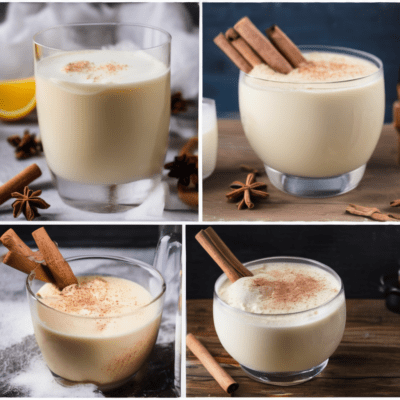


Eggnog as a Festive Gift: Perfect for Any Occasion
As an embodiment of warmth and festivity, Puerto Rican eggnog makes a perfect gift for any occasion. A bottle of homemade Coquito, wrapped with love and shared with family and friends, is a thoughtful gesture that surely won’t go unnoticed. It’s a gift that brings a slice of Puerto Rican sunshine to any holiday celebration.
Exploring Global Variants of Eggnog
Exploring global variants of eggnog reveals a fascinating array of similar creamy beverages enjoyed in various cultures around the world. While the core ingredients of eggs, milk, and spices remain consistent, each region puts its own unique twist on the classic recipe. Here are a few notable examples:
- Advocaat (Netherlands): Advocaat is a Dutch creamy liqueur made from eggs, sugar, and brandy. It has a thick and smooth consistency similar to custard and is often enjoyed chilled as a dessert or mixed with other spirits in cocktails. Its rich flavor and velvety texture make it a beloved treat during the holiday season and special occasions in the Netherlands.
- Rompope (Mexico): Rompope is a Mexican version of eggnog that originated in the convents of Puebla during the colonial period. It is made with milk, sugar, egg yolks, vanilla, and rum or grain alcohol. Rompope is traditionally served chilled and garnished with ground cinnamon or nutmeg. Its creamy texture and sweet, spiced flavor make it a popular choice for celebrations and festivities throughout Mexico.
- Eierlikör (Germany): Eierlikör, or egg liqueur, is a German beverage made from egg yolks, sugar, and rum or grain alcohol. It has a rich and velvety consistency with a sweet and creamy flavor profile. Eierlikör is often enjoyed as a standalone drink, served chilled in small glasses, or used as a topping for desserts such as ice cream or cakes. It is particularly popular during the winter months and Christmas season in Germany.
- Cola de Mono (Chile): Cola de Mono, which translates to “Monkey’s Tail,” is a traditional Chilean holiday drink similar to eggnog. It is made with milk, sugar, coffee, spices (such as cinnamon and cloves), and aguardiente or rum. Cola de Mono is typically served chilled and enjoyed during Christmas gatherings and festivities in Chile. Its creamy texture and aromatic flavors make it a beloved seasonal treat.
- Coquito (Puerto Rico): Coquito is a Puerto Rican eggnog variant that features coconut milk, sweetened condensed milk, evaporated milk, rum, and spices such as cinnamon and nutmeg. It has a rich and creamy texture with a tropical twist, thanks to the addition of coconut milk. Coquito is a popular holiday drink in Puerto Rico and among the Puerto Rican diaspora, often shared with family and friends during Christmas celebrations.
These global variants of eggnog showcase the diversity of flavors and traditions associated with creamy holiday beverages around the world. Whether enjoyed chilled, spiked with spirits, or used as a base for cocktails, these drinks bring warmth and cheer to festive occasions across cultures.
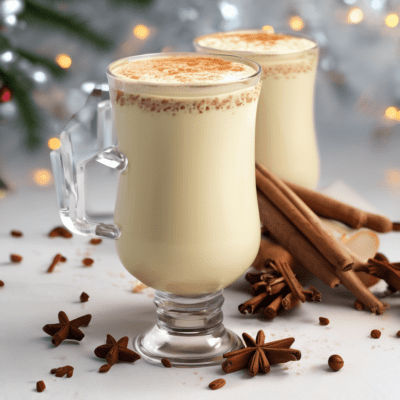


Wrapping Up: The Journey of Puerto Rican Eggnog
The journey of Puerto Rican eggnog is a testament to the power of tradition and innovation. Season after season, this rich, creamy drink continues to bring joy and warmth to holiday celebrations. Its unique blend of flavours and its soothing creaminess make it a beloved staple in Puerto Rican culture, and increasingly, around the world.
